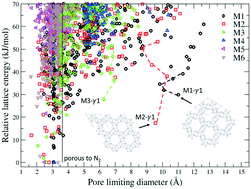In silico design and assembly of cage molecules into porous molecular materials†
Abstract
Porous materials based on organic cage molecules are an exciting alternative to porous framework materials. Their modular chemistry offers significant structure tunability while their solution processability facilitates their assembly in functional structures in either a crystalline or an amorphous phase. The family of imine cages have been the most widely studied, with several analogues synthesized and tested in applications such noble gas separation, water purification and sensing. The crystals reported so far based on the imine cages obtained by condensation of 1,3,5-triformylbenzene with several vicinal diamines (1,2-diamine) have rather small pore diameters. For example, the benchmark Covalent Cage 3 (CC3) crystal has a pore limiting diameter of 3.65 Å, and may experience diffusion limitations hindering its technological applications. The results reported so far suggest that larger cavities are generally not supported in the crystal phase, unless they are stabilized by solvent molecules. In this work, we employ a density functional theory-refined crystal structure prediction approach to perform screening of various CC3 analogues to identify cages that can support stable low density porous structures. Based on the analysis of the crystal energy landscapes, we present a number of synthetically accessible phases that support pore limiting diameters longer than 10 Å.



 Please wait while we load your content...
Please wait while we load your content...